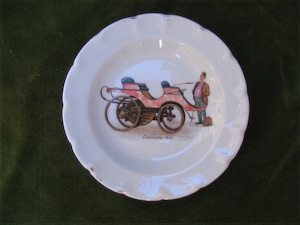|
The 18th century: The start
Since the 18th century, from the start of the production, the reputation of Limoges porcelain has developed in such a way that the name of the city has become synonymous with porcelain.
In 1768 a riverbed with clay suitable for making porcelain was found in France in Saint-Yrieix-la-Perche, close to Limoges.
With this discovery Limoges porcelain originated and developed further. Under the auspices of Turgot, Intendant of Limousin, who foresaw a source of income for the region, the first factory was established in 1781. From 1784 this factory was placed under the patronage of the Comte d'Artois.
Limoges decorative style utlises traditional porcelain subjects such as small clusters of flowers picked out in jet. Gold and blue filigree lacework is also very typical. The forms produced are simple and not numerous. After the factory was bought by the one in Sèvres, the forms and decorations were further developed and became more refined.
|
|
Between 1771 and 1774 only the biscuit porcelain was marked. From 1774 the initials of the prince, CD, were used as a mark until the closure of the factory in 1796. During the production process the objects got an impressed mark; after the decoration had been applied most objects received a painted mark, generally red, but sometimes blue.
|

Ashtray of Limoges porcelain. |
|
Limoges porcelain in the 19th century
The first half of the 19th century: the founders of porcelain
After the French revolution the production was resumed and the number of factories multiplied in the Haute-Vienne. In 1827 16 factories existed and by 1850 this number had increased to more than 30. Their history is very complicated, not only because of the large number, but they also emerged and disappeared depending on political and economic crises. Some factories of name characterise this period, particularly those of Baignol, Pierre Tharaud, François Alluaud and of the Comte de Bonneval. From 1830 the production developed, under the influence of Parisian artists such as bronze workers Aaron and Valin, more towards decorative arts. However, table services were still being produced.
Second half of the 19th century: the golden age for Limoges porcelain
The world exhibitions stimulated competition and development for the factory. That is why, as of 1851, the objects were marked, so that they could be recognized by the thousands of visitors of the exhibitions. The expertise and technical knowledge of the factories were undisputable. This is also the era when the factories aimed at developing the name Blanc de Limoges, in order to endorse the quality of the porcelain clay and the perfection of the production technique. The objects shown impress with their perfect form and their whiteness. The most representative factory is without any doubt the one of Pouyat. The piece de resistance, a rise grain service presented at a world exhibition, was realised after a design of the renowned Parisian artist Albert Dammousse. The technique used consisted of hollowing out the porcelain, after which the holes were filled with translucent enamel.
The factory of Haviland dominated the last quarter of the century. Félix Bracquemond, artistic director of a research workshop which was opened by C.E. Haviland in the district Auteuil in Paris, introduced decorations in Limoges inspired by Japanese ones. Thanks to its American offices, Haviland opened up the market for Limoges porcelain on the other side of the Atlantic Ocean.
Besides the famous white porcelain, Limoges developed the technique of Grand Feu (baking at a very high temperature), which makes it possible to obtain elegant and subtle colours.
Limoges porcelain in the 20th century
The first half of the 20th century is characterised by the development of 2 styles: Art Nouveau and Art Déco. These styles influenced the production of porcelain manufacturers who worked closely together with renowned artists.
It is thanks to the company GDA that the Art Nouveau style was introduced in Limoges porcelain. Samuel Bing, initiator of this style, had noticed the company at the world exhibition of 1892 in Chicago, and asked them to produce models designed by the artists Edward Colonna, Georges de Feure and Paul Jouve.
The reputation of Limoges porcelain is again confirmed at the exhibition 'Exposition internationale des arts décoratifs et industriels modernes' which is held in Paris in 1925. This exhibition gave its name to the style developed in the 1920s: Art Déco. Many factories worked together with artists of note like Lalique, Dufy and Sandoz. Some of the services produced have very architectonic forms, close to cubism.
Second half of the 20th century
The Second World War was of great influence on Limoges porcelain. Porcelain manufacturers decided to renew their production. They worked together with designers who designed both original and practical objects. For example Raymond Loewy designed a service for Air France in 1976. From the beginning of the production until the present day the forms and decorations of porcelain evolved together with artistic styles. It can be said that porcelain's viability is guaranteed as a result of a mutual stimulation between artists and manufacturers.
|




